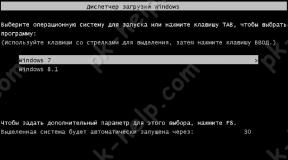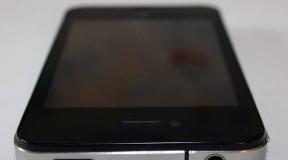Information about the dimensions and weight of the device, presented in different units of measurement. Materials used, colors offered, certificates
With the Laser console, Asus has always been a more affordable version of the company's flagships. We remember the previous generation of the series as very good devices with well-balanced characteristics. However, they were never able to compete with devices from Xiaomi, Meizu and other Chinese manufacturers that dominate the mid-price category. Will the situation change now? Read our Asus review ZenFone 3 Laser, in which we will test the new product and analyze its strengths and weaknesses in detail.
Price and main characteristics
Official retail sales ZenFone 3 Laser (ZC551KL) has already launched in Russia, the cost of the model is 17 thousand rubles.
Specifications:
- display: 5.5”, IPS FHD 1920*1080 px;
- processor: Snapdragon 430 (1.4 GHz) + Adreno 505 video accelerator;
- RAM: 2 GB;
- internal memory: 32 GB + memory cards up to 128 GB;
- camera: main – 13 MP (dual flash, laser autofocus, aperture 2.0), front – 8 MP;
- communication: Wi-Fi, Bluetooth 4.1, GPS, LTE;
- battery: 3000 mAh.
Case dimensions – 149*76*7.9 mm, weight – 150 grams.
Equipment and appearance
The smartphone is packaged in a fairly large box made of white cardboard, on which images of the device and its main characteristics are printed.
The package includes:
- USB-C cable and charging adapter;
- paper clip for card tray;
- wired headset.

The sound quality of the headphones is quite good and undemanding users will be able to use them to listen to music.

ZenFone 3 Laser does not have an unusual appearance; it is similar to many other smartphones with an all-metal body, but the device looks neat and the build quality deserves the highest rating.

The front side of the smartphone is covered with a rounded 2.5D protective glass, under the screen – touch buttons controls, above it there is a front camera, a speaker and a sensor unit. The glass has a good oleophobic coating and is easily wiped off from fingerprints.

On the back side there are 2 inserts for antennas, stylized as a chrome rim (the same frames the front part of the case). The camera module, near which there is a two-tone flash and an autofocus laser rangefinder, protrudes significantly beyond the body.

An unusual solution is a rectangular fingerprint scanner. This form does not affect its performance; the sensor responds quickly and adequately. Problems are observed only in the case of wet hands, but this is a common problem with any fingerprint sensors. In addition to unlocking the phone, you can use the sensor to launch the camera, take pictures and receive calls. It is capable of recognizing up to 5 different fingerprints, each of which can be set to launch the required application.

The layout of the ends of the smartphone is standard. At the top is a 3.5 mm jack.

Bottom – USB-C port, and the main speaker hole.

On the right is the volume key and the power button.

On the left is a slot for a hybrid card tray, which can hold 2 SIM cards or a SIM card and a memory card.

For a screen diagonal of 5.5 inches, the smartphone is quite compact, primarily due to the small thickness of the side frames. However, due to the rounded shape of the ends and the smooth surface of the metal, it slips in the hand and constantly tries to slip out. For comfortable use, ZenFone 3 Laser must be put in a case.
Screen
Display is a strong point of this smartphone. Here we use high-quality IPS matrix with FHD resolution, covered with protective glass Gorilla Glass 3. Color rendering, contrast, color temperature, brightness range - everything is at a very decent level, especially considering the cost of the device.

The cool thing about ZenFone 3 Laser is the presence of a glove control mode, the implementation of which has no complaints. There is also a blue light filtering mode, which makes it easier to read in a dark room, and a fine-tuning function for the screen: you can independently control the white balance, color shades and screen saturation.
Performance
ZenFone 3 Laser is equipped with a processor Qualcomm Snapdragon 430, operating at a maximum frequency of 1.4 GHz, and an Adreno 505 video accelerator. The smartphone has 2 GB of RAM and 32 GB of internal memory, and supports flash cards up to 128 GB.

Interface jitters when everyday use was not noticed, the ZenUI shell is perfectly optimized. The device copes with Full HD video playback, surfing heavy websites and any standard tasks without any problems. In the Antutu Benchmark test, ZenFone 3 Laser scores 45 thousand points. The gaming performance of the smartphone is enough to run resource-intensive games, but in the same tanks, to get 50 FPS, you need to reduce the graphics settings to low.
Camera
When it comes to photography, ZenFone 3 Laser is good, it’s not for nothing that it is positioned as affordable smartphone for amateur photographers. When shooting during the day, there is nothing to complain about at all - excellent detail, pleasant colors, wide dynamic range.

When the lighting deteriorates, the picture begins to become slightly blurry, but the quality does not drop catastrophically, and there are no problems with focusing - thanks to laser autofocus, the smartphone correctly captures even fast-moving objects.



The standard camera application offers excellent functionality. In addition to good HDR and many automatic modes for different shooting scenarios, there is a manual settings allowing, for example, to set the shutter speed to 32 seconds.


Maintains the ZenFone 3 Laser brand when shooting video. It can’t shoot in 4K and doesn’t have optical stabilization, but the digital stub copes well with its tasks, and the 1080p 60fps picture itself is smooth, has good detail and correct color rendition.
Speaker, sound quality
The new product from Asus boasts good sound in headphones. On board the smartphone there is an NXP Smart AMP amplifier, due to which it can drive even high-impedance headphones. Music lovers will like the sound quality - the music plays in detail, you can feel the stage, the elasticity of the bass and clear high frequencies. Not at the level of flagships from Meizu, but very worthy.

The manufacturer focused a lot of attention on the main speaker of the smartphone - it is made using 5 magnets and a special voice coil, which should provide high-quality sound. In practice, things are more modest; it is loud, but we did not notice record clarity and richness of sound. You can compare the speaker with that of Xiaomi Redmi 3S.
Battery
ZenFone 3 Laser is equipped with a 3000 mAh battery. The smartphone confidently survives until the evening even with intensive use; with continuous playback of FHD video, the charge lasts for 7.5 hours; when gaming, the battery is discharged by 18-20% per hour. There is no QuickCharge function; charging takes about 2 hours.
Communication and Internet
The smartphone works with two SIM cards, but has one radio module. The quality of network reception is consistently good, there is support for 3G and LTE. The connection time with navigation satellites on a cold start is 45 seconds; the phone confidently found 25 satellites during the test.

Wireless interfaces include Wi-Fi and Bluetooth 4.1. There is also a connection to external devices via USB Type-C.
Video review of Asus ZenFone 3 Laser
Competitors, conclusion
If you need a smartphone for gaming, then ZenFone 3 Laser will definitely be a bad choice - for 17 thousand, the market is full of more powerful solutions (Xiaomi RN3P, ZUK Z2). But in terms of photo capabilities, the hero of our review is one of the best in its class; only the hero can compete with him on an equal footing!
Now more than ever, it's possible to spend $400 or less on a smartphone that's only slightly inferior to devices twice the price. This is great news for buyers who want to get a quality device at affordable price, but this also means that manufacturers have to strain and create different models from each other. With such competition in the smartphone market, this is not easy to achieve.
The company is not new to the market, having become one of its leaders in 2015 with the advent of the ZenFone 2. Although it had a rather dull design, there was hope for its further development.
In 2016, Asus introduced many varieties ZenFone smartphones 3, one of the cheapest options was ZenFone 3 Laser. The last word hints at the presence of laser autofocus in the camera, but there are many other advantages.
The ZenFone 3 Laser retails for under $200, making it a direct competitor to the Moto G4. Should I give preference to the Asus model?
Contents of delivery
- Smartphone Asus ZenFone 3 Laser
- microUSB cable
- SIM Removal Tool
- Warranty and Safety Information
Design

The Asus ZenFone 3 Laser is a big step up in terms of build quality over the ZenFone 2, ditching plastic in favor of aluminum. Changing the material is a great solution as aluminum gives the smartphone a premium look and feels comfortable in the hand. The back surface is smooth and pleasant to the touch, located under the camera protrusion, allowing you to quickly and conveniently unlock the device. The body thickness of this smartphone is only 7.9 mm, it weighs 150 g, that is, it is very thin and light. Rounded corners make it more comfortable to hold in your hand.
Despite the aluminum body, the appearance of the smartphone is quite standard. A great many similar devices have already been released both in the budget and premium segments, so the developers are not offering us anything new here.






Screen

The LCD screen resolution is 1920 x 1080 pixels, 5.5 inches diagonal. There's nothing remarkable about it, but there's nothing to complain about either. The text is clear, the colors are bright, and the viewing angles are quite wide. For a smartphone in this price range, you can't ask for more.
Interface and functionality

The device is pre-installed with an operating system Android system 6.0.1 Marshmallow, with a shell made by Asus installed on top of it. Over the years, the quality has gradually improved, so that compared to the version on ZenFone 2, it has become noticeably more attractive. Despite this, her appearance remains somewhat cartoonish, although this is a matter of taste.








Not to mention appearance, Asus has made quite a few useful improvements to the system, the built-in bootloader can be flexibly configured, there is a high-quality theme engine, and the screen understands many gestures.
Processor and performance
ZenFone 3 Laser runs on a processor, volume random access memory 2 GB. The processor has eight cores with a frequency of 1.4 GHz. It is intended for devices in the lower and mid-price categories, which can be seen in the performance of this model.
The smartphone copes with most basic tasks without problems. These include browsing, usage, and even games like Asphalt 8: Airborne. The small amount of RAM means that when you open many applications, inactive ones are quickly removed from memory and need to be loaded again.
This is what you would expect from a smartphone priced at $199, so this device is not for those who prefer to open many programs at once.
Connection
The smartphone has two slots for SIM cards, you can use different tariffs for voice communication and mobile internet. Instead of one SIM card, you can install one, which will expand the built-in flash memory capacity of 32 GB. There is support Wi-Fi networks 802.11 b/g/n and Bluetooth 4.2.
The downside is the microUSB 2.0 connector for synchronization and charging instead of the more modern USB type C.
Cameras

Cameras on budget smartphones usually suffer from savings more than other components. The ZenFone 3 Laser camera is also not outstanding, but for most users its capabilities will be quite sufficient.
Asus did not use a dual camera module, instead choosing one with a resolution of 13 megapixels on the back and 8 megapixels on the front. The main camera of the smartphone, as its name suggests, has laser autofocus. You don't usually see this on cheap smartphones, so this is a pleasant surprise.
Photo quality and video recording
The photos are of high enough quality to be posted on social networks, but you need to keep in mind their shortcomings. Outdoor photos look good, but the less light there is, the lower the quality. When this happens, there is often a problem with focus and the detail of the pictures drops. Video recording at 1080p also produces decent images, but the lack of image stabilization means it will be shaky.
As mentioned above, the screen on this smartphone is bright and multi-colored, it is pleasant to watch videos and play games on it. Unfortunately, the quality of the multimedia experience is significantly degraded by the speaker.








The main drawback is the low speaker volume. Even at maximum volume, you may have trouble hearing the sound, especially in noisy environments. At the same time, at maximum volume the purity of the sound is distorted.
The good news is that there is an analog 3.5mm headphone jack, no adapters or wireless headphones not required.
Call quality
U modern smartphones there are no problems with incoming and outgoing calls, neither does the Asus ZenFone 3 Laser. The sound quality at both ends of the line is good, and the rounded corners of the screen make it comfortable to hold the device in your hand.
Autonomous operation
The smartphone offers decent battery life. If you actively check email on two accounts, work with numerous social networks, watch videos on YouTube in Full HD resolution, listen to music via Bluetooth headphones, the device will last about a day and a half.
The battery capacity is 3000 mAh. The device was turned on at 8:00 am and discharged the next day at 14:45. As for tests with the screen always on, the smartphone lasted 5 hours and 13 minutes.
The downside of the battery is the long recharging time. From zero to 100% it charged in 3 hours and 25 minutes.
Conclusion
Asus did impressive work and offered a smartphone that has many advantages at a price three times less than the flagship model. Although its design is quite typical, the quality of the materials allows it to look no worse than more expensive devices.

The smartphone also offers a high-quality screen, relatively fast processor, fast autofocus and good duration battery life. Relatively weak points are the shell operating system, poor quality speaker and long charging time, but otherwise the smartphone is very good. At $200, it would be hard to find a better option instead.
pros
- Build quality
- Thin and light
- Large, bright and multi-color screen
- Fast laser autofocus
- Good battery life
- Value for money
Minuses
- Navigation buttons without backlight
- Bad speaker
- Charging time
Mobile phone ASUS ZenFone 3 Laser ZC551KL 32GB (gold)
BEAUTIFUL METAL CASEASUS ZenFone 3 Laser reflects the highest craftsmanship and impeccable taste. Metal body with a carefully polished surface, thoughtful ergonomics, two premium colors (silver and gold) - this is a masterpiece of modern design and innovative technology that you won’t want to let go of.
BRIGHT AND CLEAR IMAGES
ASUS ZenFone 3 Laser features a stunning 5.5-inch display, Full resolution HD and a brightness of 500 cd/m2, which provides high-quality images even on the sunniest day. The screen is covered with durable protective glass with rounded edges. Thanks to the ultra-thin frame (2.58 mm) and large area (more than 77% of the size of the front panel), it does not in any way affect the compactness of the smartphone.
EXCELLENT SPEED AND REALISTIC IMAGES
PixelMaster 3.0 technology takes the photography capabilities of ZenFone 3 Laser far beyond what is available on regular smartphones. To capture the unique beauty of the world around you in its own unique glory, this model is equipped with a 13-megapixel sensor, a fast f/2.0 lens and a highly accurate laser autofocus system that fires in just 0.03 seconds. If we add to this an effective electronic image stabilization system and a color correction sensor, then there is no doubt: clear pictures and videos with accurate rich colors can be obtained literally with one touch. PixelMaster 3.0 is a real revolution in mobile photography.
PHOTOS THAT LOOK LIKE THE REAL WORLD
A special technology for manufacturing a light-recording matrix with deep pixel insulation, which blocks the flow of light photons between adjacent cells, improves the overall image quality. Thanks to the color correction sensor, which detects objects in the frame with non-standard lighting, it becomes possible to take pictures with the most natural color reproduction. These features work well with advanced shooting modes such as 4x Super Resolution mode and Advanced mode. dynamic range(HDR) with the result displayed in real time - even before you press the shutter.
8MP FRONT CAMERA
ZenFone 3 Laser is equipped with an 8-megapixel front camera, and the portrait enhancement function allows you to automatically decorate selfies in real time: remove skin blemishes, correct facial features.
MULTIFUNCTIONAL FINGERPRINT SCANNER
The fingerprint scanner located on the rear panel not only serves to instantly unlock the smartphone, but also supports several other useful functions. For example, by swiping it from top to bottom, you will activate the front camera to take a selfie, so that you can then take a photo by touching the same scanner, which in this case will act as a backup shutter button. Double-tapping the scanner allows you to receive incoming calls, and the launch of your favorite applications (up to five!) can be linked to touches with different fingers.
SPEAKER WITH 5 MAGNETS
Using a 5-magnet speaker and a metal-framed voice coil, ASUS ZenFone 3 Laser delivers rich, clear sound. To configure it, use the AudioWizard utility, which offers you to choose one of several modes, each of which is ideal for a specific type of application (movies, games, music, etc.).
IMPROVED USER INTERFACE
The ZenFone 3 line of smartphones features ZenUI, a user interface designed specifically for mobile devices ASUS, so you get an improved design, increased performance and many additional functions compared to the standard interface. Convenient and functional, ZenUI 3.0 is not just a user interface, it is a reliable assistant that is always at hand!
The rear camera of the ZenFone 3 Laser smartphone is equipped with an instant laser focusing system...
The device works with Nano-SIM cards from all GSM operators.
PixelMaster 3.0 technology. Excellent speed and realistic pictures.
PixelMaster 3.0 technology takes the photography capabilities of ZenFone 3 Laser far beyond what is available on regular smartphones. To capture the unique beauty of the world around us...
The device works with Nano-SIM cards from all GSM operators.
PixelMaster 3.0 technology. Excellent speed and realistic pictures.
PixelMaster 3.0 technology takes the photography capabilities of ZenFone 3 Laser far beyond what is available on regular smartphones. To capture the unique beauty of the world around you in its own unique glory, this model is equipped with a 13-megapixel sensor, a fast f/2.0 lens and a highly accurate laser autofocus system that fires in just 0.03 seconds. Combine this with an effective electronic image stabilization system and a color correction sensor, and you can rest assured that clear photos and videos with accurate, rich colors can be achieved with just one touch. PixelMaster 3.0 is a real revolution in mobile photography.
Second generation instant autofocus system.
The rear camera of the ZenFone 3 Laser smartphone is equipped with a second-generation instant laser focusing system that operates in just 0.03 s. To focus, she measures the distance to the object being photographed by firing a laser beam and timing the time it takes for it to reflect back to her sensor. This system helps you take clear pictures even in adverse conditions.
Electronic image stabilization. Video shooting without shaking or vibration.
3-axis electronic stabilization helps you record smooth videos even when shooting handheld or on the move.
For colorful selfies. 8 megapixel front camera.
ZenFone 3 Laser is equipped with an 8-megapixel front camera, and the portrait enhancement function allows you to automatically decorate selfies in real time: remove skin blemishes, correct facial features, etc.
Design. Beautiful metal body.
ZenFone 3 Laser reflects the highest craftsmanship and impeccable taste. A metal case with a carefully polished surface, thoughtful ergonomics, two premium colors (silver and gold) - this is a masterpiece of modern design and innovative technology that you won’t want to let go of.
Protection.Multifunctional fingerprint scanner.
The fingerprint scanner located on the rear panel not only serves to instantly unlock the smartphone, but also supports several other useful functions. For example, by swiping it from top to bottom, you will activate the front camera to take a selfie, so that you can then take a photo by touching the same scanner, which in this case will act as a duplicate shutter button. Double-tapping the scanner allows you to receive incoming calls, and the launch of your favorite applications (up to five!) can be linked to touches with different fingers.
High performance in multitasking mode.
ZenFone 3 Laser uses the 64-bit Qualcomm Snapdragon 430 processor, which combines high performance with low power consumption. Its power is enough for fast work any mobile applications, which is also facilitated by a large amount of RAM - up to 4 GB.
Battery. Long battery life.
ZenFone 3 Laser is designed for people leading a mobile lifestyle, and therefore is equipped with a 3000 mAh battery that provides up to 22 days of battery life in standby mode.
SonicMaster technology.Speaker with 5 magnets.
Using a 5-magnet driver and a metal-framed voice coil, ZenFone 3 Laser delivers rich, clear sound. To configure it, use the AudioWizard utility, which offers you to choose one of several modes, each of which is ideal for a specific type of application (movies, games, music, etc.).
ZenUI 3.0. Improved user interface.
The ZenFone 3 line of smartphones features the ZenUI user interface, designed specifically for ASUS mobile devices.
While professional photographers were figuring out which was better - Nikon or Canon - the world turned upside down. The most popular device for photography has become the smartphone. Many people have long given up their cameras, since the phone camera successfully solves all typical problems. True, the most advanced technologies first of all end up in top-end devices, which many simply cannot afford, and for those who want an inexpensive device with one pronounced function, the choice is very modest. And from this point of view, ASUS is doing everything right. For fans of huge screens, there's the Zenfone 3 Ultra. For those who believe that there is nothing more important than a capacious battery, there is Zenfone 3 Max. well and ASUS Zenfone 3 Laser is available phone for those for whom a high-quality camera is especially important.
Of course, about the most advanced module in budget smartphone out of the question, but overall the camera parameters of the Zenfone 3 Laser look decent. A little later we will talk in detail about how laser focusing works and why it is needed at all. In the meantime, it’s worth taking a look at the main parameters of the model.
Specifications
| ASUS Zenfone 3 Laser (ZC551KL) | ASUS Zenfone 2 Laser (ZE551KL) | Sony Xperia XA Ultra | Huawei Honor 5X | |
|---|---|---|---|---|
| Screen | 5.5 inches, IPS, 1920 × 1080 pixels, 501 ppi, capacitive multi-touch |
5.5 inches, IPS, |
6.0 inches, IPS, 1920 × 1080 pixels, 367 ppi, capacitive multi-touch |
5.5 inches, IPS, 1920 × 1080 pixels, 401 ppi, capacitive multi-touch |
| Protective glass | Corning Gorilla Glass 3, with oleophobic coating and polarizing filter | Yes, manufacturer unknown | No data | |
| CPU | Qualcomm Snapdragon 430 MSM8937: eight cores (8 × 1.4 GHz) ARM Cortex-A53 | Qualcomm Snapdragon 615 MSM8939: eight cores (4 × 1.7 GHz, 4 × 1.0 GHz) ARM Cortex-A53 | Mediatek MT6755 Helio P10 (four ARM Cortex-A53 cores, 1.2 GHz + four ARM Cortex-A53 cores, 2 GHz) | Qualcomm Snapdragon 615 MSM8939v2: eight cores (4 × 1.2 GHz, 4 × 1.5 GHz) ARM Cortex-A53 |
| Graphic controller | Adreno 505, 450 MHz | Qualcomm Adreno 405, 550 MHz | ARM Mali-T860 MP2, 700MHz | Adreno 405, 550 MHz |
| Operational memory | 2/4 GB | 3 GB | 3 GB | 2 GB |
| Flash memory | 32/64 GB | 16/32 GB | 16 GB | 16 GB |
| Connectors | 1 micro-USB | 1 micro-USB | 1 microUSB; | 1 micro-USB 2.0 |
| 1 x 3.5mm headset jack | 1 x 3.5mm headset jack | 1 x 3.5mm headset jack | ||
| 1 micro-SIM | 2 nanoSIM | 2 micro-SIM | ||
| 1 nano-SIM/microSD (universal) | 1 microSD | 1 micro-SIM/microSD (universal) | ||
| Cellular connection 2G | GSM/GPRS/EDGE 850/900/1800/1900 MHz | GSM/GPRS/EDGE 850/900/1800/1900 MHz | GSM/GPRS/EDGE 850/900/1800/1900 MHz | |
| Cellular connection 3G | DC-HSPA 850/900/1900/2100 MHz | DC-HSPA 850/900/1900/2100 MHz | UMTS/HSPA+ 900 /2100 MHz | |
| Cellular 4G | LTE Cat. 4 (150 Mbit/s, 50 Mbit/s), bands 1, 2, 3, 4, 5, 7, 8, 18, 19, 26, 28, 38, 40, 41 | LTE Cat. 7 (300 Mbit/s, 150 Mbit/s), bands 1, 2, 3, 5, 6, 7, 8, 18, 19, 26, 28, 38, 40, 41 | LTE Cat. 7 (300 Mbit/s, 150 Mbit/s), bands 1, 2, 3, 4, 5, 7, 8, 9, 17, 18, 19, 20, 28, 29, 38, 39, 40, 41 | |
| WiFi | 802.11 /b/g/n/ 2.4 GHz | 802.11/b/g/n/ 2.4 GHz | 802.11a/b/g/n/ac 2.4/5 GHz | 802.11b/g/n 2.4 GHz |
| Bluetooth | 4.2 | 4.1 | 4.1 | 4.1 |
| NFC | No | No | Eat | No |
| Navigation | GPS, A-GPS, GLONASS, BeiDou | GPS, A-GPS, GLONASS | GPS, A-GPS, GLONASS | GPS, A-GPS, GLONASS |
| Sensors | Illumination, proximity, accelerometer/gyroscope, magnetometer (digital compass) | Illumination, proximity, accelerometer/gyroscope, magnetometer (digital compass) | Illumination, proximity, accelerometer/gyroscope, magnetometer (digital compass) | |
| Fingerprint's scanner | Eat | Eat | No | Eat |
| Main camera | 13 MP, f/ 2.0, laser autofocus, dual LED flash | 13 MP, f/2.0, laser autofocus, dual LED flash | 21.2 MP, hybrid autofocus, LED flash | 13 MP, f/2.0, autofocus, LED flash |
| Front-camera | 8 MP, no autofocus, no flash | 5 MP, no autofocus, no flash | 16 MP, autofocus | 5 MP, f/2.4, fixed focus |
| Nutrition | Non-removable battery: 11.4 Wh (3000 mAh, 3.8 V) | Removable battery: 11.4 Wh (3000 mAh, 3.8 V) | Non-removable battery: 10.2 Wh (2700 mAh, 3.8 V) | Non-removable battery 11.7 Wh (3000 mAh, 3.9 V) |
| Size | 149 × 76 × 7.9 mm | 152.4 × 77.2 × 10.9 mm | 164 × 79 × 8.4 mm | 151.3 × 76.3 × 8.2 mm |
| Weight | 150 g | 170 g | 202 g | 158 g |
| Water and dust protection | No | No | No | No |
| operating system | Android 6.0 Marshmallow, ASUS ZenUI shell | Android 5.0 Lollipop, ASUS ZenUI shell | Android 6.0 Marshmallow, Sony Xperia shell | Android 5.1 Lollipop, EMUI shell |
| Current price | 16,990 rubles | 12,000 rubles | 27,990 rubles | 14,990 rubles |
|
|
|
|
Design, ergonomics, software
The design can be assessed from two sides: either praise the stylistic unity of the entire Zenfone 3 series, or criticize ASUS for its reluctance to add individuality to each smartphone. However, now all smartphones are similar in one way or another - the standards set ten years ago hardly change, only the display diagonals increase and the thickness decreases.

The smartphone is offered in only two colors: silver and gold. The second option looks more interesting, although this is, of course, not for everybody. Here the color is not as saturated as, for example, in the iPhone, but I would still like it more choice: where is black, dark gray, and even pink?

The front panel is completely covered with tempered glass with a fashionable 2.5D effect. The edges are slightly rounded around the perimeter, which contributes to a smoother transition to the side edge. You are unlikely to notice it by eye, but holding the smartphone will be a little more convenient. There is a lens above the display front camera, voice speaker and proximity sensor, and under the screen there are touch control buttons. ASUS Zenfone 3 Max, if you remember, did not have such buttons - only on-screen keys were used, which reduced the effective display area.


On the bottom edge there is only a microphone under a nice grille and a microUSB connector. However, it is worth noting here that the lower and upper sections of the case on the rear panel are not metal, like its main part, but plastic. I don’t think that a potential smartphone buyer will be happy after learning about this feature, but ASUS has an excuse - such inserts help better work wireless modules. And indeed, the smartphone is in complete order with this. In addition, the plastic does not give itself away - it is painted the same color and has the same texture as the metal base of the case.


On the left side there is traditionally a tray for SIM cards, on the right there is a power key and double button volume adjustment. It is also used to release the shutter in shooting mode. It’s nice that these elements are located in the upper third of the side edge - it’s easy to press them with your thumb. Recent experiments by Sony, in which the volume key was located at the bottom, still make us think about where it is better to place the volume control. In my opinion, the ASUS option is more convenient.

On the back of the case there is a flash, a protruding camera lens (which, apparently, is easy to scratch), a laser window and a rectangular, elongated fingerprint reader area. In my opinion, this arrangement of the fingerprint scanner is a little less convenient than on Home button or the power key, but these are minor things. The shape seemed a little awkward to me - the square scanner of the ASUS Zenfone 3 Max was more comfortable to handle.

The dimensions of the device are large (149 × 76 × 7.9 mm), but you can hold it with one hand and it does not cause discomfort. You won't be able to reach the top areas of the screen with your thumb, but typing on the go is quite possible. It is worth noting that even among 5.5-inch smartphones, ASUS Zenfone 3 Laser remains one of the most compact, no comparison with the iPhone 7 Plus.























